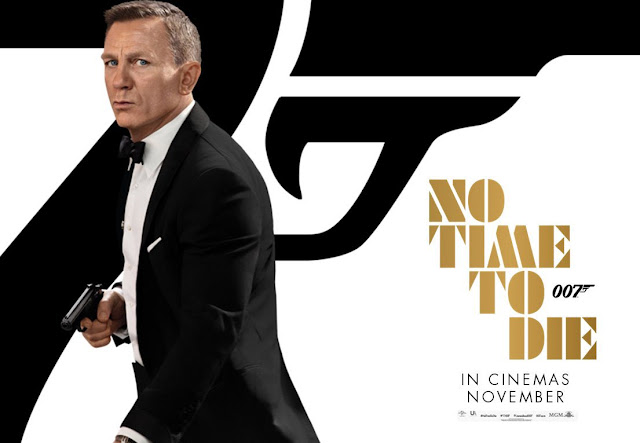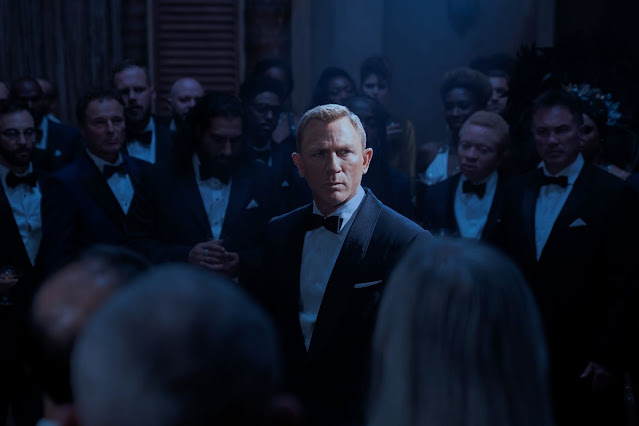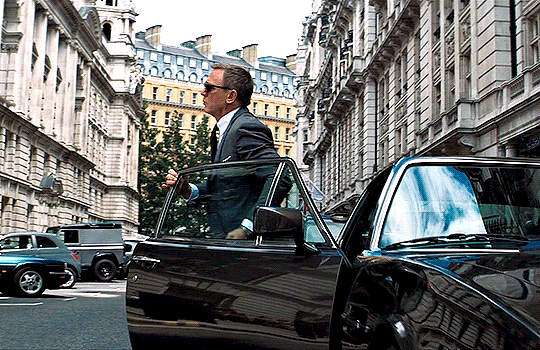Dec 28, 2021
Dec 26, 2021
Dec 13, 2021
NO TIME TO DIE (2021)
[Warning: Major spoilers follow for No Time To Die.]
What began in 2006 with Casino Royale ends with this year’s No Time To Die, which sees Daniel
Craig’s fifth and final outing as James Bond, world-traveling, martini-shaking
international superspy. Though his films deviated in terms of quality from one
entry to the next like those of previous Bond actors, Craig proved to be among
the most popular Bonds of the character’s cinematic history—if not the most popular. (Some folks will never surrender their love for Sir Sean
Connery.) I’ll freely admit, except for random dalliances here and there, I’m
not a student of James Bond. I barely engaged with the series prior to Pierce
Brosnan’s first appearance in 1995’s Goldeneye;
I’ve seen just a few Brosnans, not a single Connery, and I’ve only got one
Roger Moore under my belt. (That sound you just heard is an entire Internet’s
worth of Bond fans slapping their foreheads in disgust.) In this review for James Bond: Part 25, I mention this for
a reason: though numerous sacred franchises and IPs from my adolescence were
reborn during my young adulthood in the early 2000s, for once, I was the target
for the new millennium’s rebooted James Bond series—I was fresh blood, an
untapped viewer to hook and reel in for the multiple movies typically dictated
by any new Bond actor’s contract. The strength of Martin Campbell’s exciting
direction with Casino Royale, the
fierce but suave portrayal of Bond by Craig, and the sincerer and less cheeky
tone of this new era was an ideal way to introduce me to the concept (and Eva
Green’s presence sure didn’t hurt); with just one movie, all my preconceived
notions accumulated by years of parodies, rip-offs, and pop culture references
had been blasted away. This was a Bond I could finally get behind, and for
fifteen years, I did.
Starting with Casino Royale, the series followed an
up-and-down trajectory in quality. Though 2008’s Quantum Of Solace didn’t plumb the same kind of lows as Brosnan’s
worst entries, it was still a step
down when compared to the series’ heart-defibrillating predecessor. Then came
2012’s Skyfall, directed by
celebrated filmmaker Sam Mendes (1917),
clearly Craig’s second-most beloved entry, followed by another step down with
2015’s Spectre, which pulled a very
rare series hat trick in having Mendes immediately return as director, and whose
Christoph Waltz was dogged by so many questions and speculation that he was
playing the iconic Ernst Blofeld, which the actor denied at each turn, that
once the movie was released and he was revealed
as such, all the impact of the revelation had been sucked out of the room.
(Waltz returns briefly in No Time To Die,
his Blofeld channeling Hannibal Lecter behind glass prison walls just like Skyfall’s Javier Bardem before him.) In
my estimation, Craig never made a straight-up bad Bond film, though it was easy
to be disappointed by some of his entries because of how well made and exciting
his best ones were, and how “event” the series is in general; with this prestige
came unreasonable expectations, as audiences no longer expected “okay”
entries—they wanted to be blown away each time, and that rarely happens with a
long-running series, even one with the luxury of reinventing itself each time a
new actor steps into the superspy’s tuxedo. Because of this trajectory, and for
many other reasons—Craig’s vocal refusal to play the character again after Spectre (he very dryly conjured threats
of suicide as an alternative), the public exit by original director Danny Boyle
(28 Days Later), the hiring of True Detective’s Cary Fukunaga as his
replacement, the high-pressure responsibility of being the final Craig Bond film, and its twenty-three-month
delay caused by the ongoing pandemic—all eyes were on 2019’s 2020’s
2021’s No Time To Die.
Unlike the more segmented,
one-off adventures of Bond arcs in the past, all of Craig’s entries had fed
into each other in some manner, so to fully appreciate one or two of them
required seeing all of them. No Time To Die not only solidifies that
pattern but its entire dramatic swing depends
on it. Its opening present-day moments won’t mean a thing if you haven’t
previously witnessed the burgeoning romance between Bond and Vesper Lynd
(Green) and its subsequent, er…dissolution in Casino Royale—an experience that permanently altered Bond across
the entire series to follow, turning him from a romantic to a cynical,
distrustful womanizer for which the character is known. Initially, Spectre was designed to be the capper
for Craig’s arc, retroactively establishing all the previous films’ villains as
operating at the behest of the shadowy criminal enterprise after which the film
takes its name while also allowing Bond to retire at the conclusion of the film.
With Spectre no longer Craig’s final
outing, and in order to justify a reason to bring him back to the role, the
stakes had to be raised, and an even bigger
threat was necessitated to complement Craig’s for-realsies-this-time swan song.
No Time To Die ably accomplishes
this feat; however, instead of relying on yet another shadowy criminal
enterprise, the villainous threat comes in the form of one extremely damaged
individual with an alarmingly prescient virological axe to grind by the name of
Lyutsifer Safin (Rami Malek)—and villains don’t get any bigger than Lucifer.
It’s said that the enemy of your enemy is your friend, but when your enemy is
the enemy of everyone, there’s no shaky
alliance to be found and it’s every man for himself.
No Time To Die begins with the retirement Bond had finally
achieved, which sees him traversing the world alongside Spectre’s Madeleine (Léa Seydoux), but a suspicious attack branded
by Spectre sees the end of the couple’s harmony and Bond unofficially unretires
to chase down who could ever be so rude as to ruin the kind of picturesque and
exotic life that only exists in Hollywood fiction. His unretirement allows him
to reconvene with his former support team of M (Ralph Fiennes), Moneypenny
(Naomie Harris), the delightful Q (Ben Whishaw, voice of the eponymous bear in
the charming-as-hell Paddington series),
Tanner (Rory Kinnear), Bond’s replacement and new 007 Nomi (Lashana Lynch), and
CIA operative Felix Leiter (Jeffrey Wright). With the team back together—well,
sort of; he starts off working for the Americans before switching back to his
home team—Bond trounces across the world in pursuit of his ultimate nemesis.
Despite Craig’s very
understandable misgivings with returning to the series after Spectre (the actor broke at least one bone on every production), No Time To Die gives him the most to do
yet, emotionally, as the character. We see Bond both retired and active; we see
him content and happy before we see him crumbling and hardened; we see him
going rogue and also finding a family; and finally, we see him at his most
peaceful as the sky around him fills with an army’s arsenal. Perhaps it’s
Craig’s natural improvement as an actor, his increasing ease at playing the
character, or the harmony in knowing he’ll soon be free of the series that’s
ravaged his body and dumped on him an enormous amount of public and industry
pressure—whatever the reasons, he’s never been better to watch as James Bond,
which is a nice way to say farewell.
Director Fukunaga stages a boatload
of exciting action sequences, especially the film’s opening post-attack car
chase, but also including the much-ballyhooed sequence in Cuba, which not only
allows for the appearance of the incomprehensibly gorgeous Ana de Armas as
greenhorn agent Paloma, but all of which falls back on the sillier, tongue-in-cheek
humor that the Bond series had exercised throughout its run before the Craig era
eagerly left it behind. Though the sudden tonal shift comes off as a jarring
and alarming portent of things potentially to come, it’s made clear soon after
that this was Fukunaga’s minor deviation—his chance to craft a sequence more in
line with the quirkier Bond adventures—before righting the ship for the
remainder of the running time…except for the occasional corny zinger.
Though I opened this review with
a major spoiler warning, it bears repeating: if you know nothing about No Time To Die’s finale but intend on
seeing it, this will be your final opportunity to throw your phone out the
nearest window.
Leading up to the production of Spectre, Craig had one caveat: it would
be his final go-round as the character, and Bond would retire from the agency
at its conclusion. In spite of that, longtime producers Barbara Broccoli and
Michael G. Wilson wooed him back with a lot of sweet talk and a lot more money, only this time Craig
made damn sure he could never return
to the series. Yes, for the first time ever, the generally immortal James Bond
dies at the end of his mission, not just sacrificing himself for the sake of
his family, in perhaps the most thematically appropriate moment of his series’
arc, but acknowledging to audiences across the world that playing Bond has been
an honor, a blast, and that he is well and truly done—and the very explicit,
on-the-nose depiction of his demise is one no human being could ever come back
from. It never seemed likely that a James Bond film might actually cause me to
spill tears, but seeing Bond’s status change to “offline” on a background
computer screen in the film’s final moments came at me like a speeding Aston
Martin.
Though this has naturally proved
controversial among cinephiles, I found it to be a brave and an especially
emotional move on behalf of the series’ keepers—and besides, No Time To Die was always going to be Craig’s final appearance in the series,
regardless of how his character concluded. When he took over the series in 2006
(and please, genuinely, tell me if I’m wrong), it was never in my mind that the
James Bond seen in Casino Royale was
meant to be the same iteration of the character last seen in 2002’s Die Another Day, only this time wearing
a suspiciously different face. Casino
Royale, in my eyes, was always meant to be a brand-new beginning for the
character, the Batman Begins of the
Bond series, in spite of Judi Dench’s presence, who’d appeared as M in all of
Brosnan’s entries. As such, if Casino
Royale was a new beginning, then No
Time To Die is allowed to be a non-controversial ending. We live in a new
age for decades-spanning franchises where it’s no longer expected that every
new entry has to be a continuous story. Earlier I remarked that No Time To Die was James Bond: Part 25, but that’s not accurate; instead, it’s Daniel Craig’s James Bond: Part 5, and
once a new actor inevitably steps into the role, the dial will reset, his name
will be James Bond, and perhaps a new support staff will surround him; we may
very well see a new M or Q and everything will be brand new once again. (Personally,
I’d love to see the new arc go back in time and take place across the 1960s—it’d
be an easy way to transition to a new Bond actor and allow the dust to settle
before the series re-finds the present day.) Only time will tell what the
future holds—and like this newest entry, its moniker, and in spite of the death
of James Bond, this series will never die.
James Bond will return.







